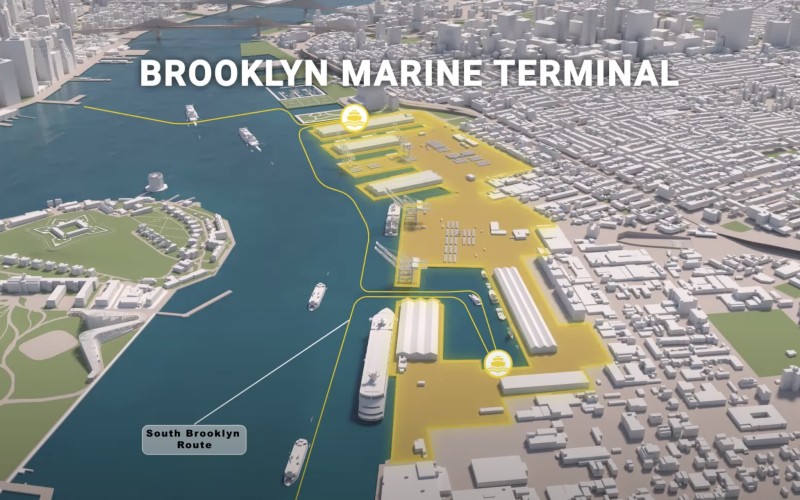Some $95 million in improvements are planned for New York’s Brooklyn Marine Terminal, with an agreement by state and city officials to remake it “into a modern maritime port and vibrant mixed-use community hub.”
The sweeping plan is for New York City to take control of the entire marine terminal, 122 acres of waterfront in Brooklyn’s Red Hook and the Columbia Street Waterfront District including the cruise ship terminal.
“Today’s announcement marks the next great chapter for Brooklyn’s storied waterfront and is a win for the people of New York City,” Gov. Kathy Hochul said at a press conference May 15 with Mayor Eric Adams and officials of the Port Authority of New York and New Jersey.
Adams said $80 million will go to stabilizing and rebuilding piers, with another $15 million for a new electrified container crane. By mid-June, the city Economic Development Corporation will assume responsibility for terminal management and operations, while supporting existing tenants, including assuming the recent five-year extension of Red Hook Container Terminal’s operating agreement.
Hochul said the agreement in principle will begin a “long-anticipated process of reimagining the Red Hook piers as a modern maritime facility that also serves community needs. Our partners at the Port Authority will ensure that the marine terminal at Howland Hook remains a thriving shipping hub, building upon the recent landmark announcement of $200 million in private investment to ensure that facility’s strong future.”
“For 20 years, skeptics thought this deal couldn’t get done,” said Adams, “but our administration prioritized the ‘Harbor of the Future’ and now we have the potential to create thousands of new jobs, generate billions in economic impact, and create a neighborhood on our shoreline that truly displays the promise of New York City.”
City officials said goals include growing the existing specialized container business, and “enable the development of a citywide micro-mobility strategy to reduce truck traffic, and work with the community and key stakeholders on a master plan to ensure the long-term viability of the port while incorporating important community amenities.”
Truck traffic and air pollution are major quality of life issues in the surrounding neighborhoods. Hochul said planners are committing $15 million for a future cold storage facility on-site that would help to reduce those problems brought on by perishable merchandise is transported in and out of Brooklyn.
The city will assemble a ‘Brooklyn Marine Terminal Taskforce’ to stakeholders including local elected officials, unions, waterfront stakeholders, Brooklyn businesses, workforce development, the adjacent community, and the maritime industry. The Economic Development Corporation is hiring community engagement and urban design firm WXY to support the process.
The city is seeking $350 million in federal funds from the U.S. Environmental Protection Agency and the U.S. Department of Transportation to improve the Brooklyn Marine Terminal “into the world's first model for a modern maritime facility optimized for international cargo handling, as well as low-carbon, last-mile freight movement,” according to a summary.
The funding requests would prioritize replacing the defunct Piers 9a and 9b with a new marginal pier for greater capacity to handle international containers and micro-freight, and traffic improvements to improve traffic flow around the Brooklyn Cruise Terminal and in the Red Hook community.
Across the harbor, the city will amend its lease of a 225-acre portion of Staten Island’s Howland Hook Marine Terminal to the Port Authority, which currently leases Howland Hook from the city, to give Port Authority operational control of the site. That will bring the entirety of Howland Hook under Port Authority control to help drive future expansions.
Howland Hook is one of the key container terminals in New York Harbor. In September 2023 Howland Hook’s operator, global shipping and logistics company CMA CGM, committed more than $200 million for modern facilities, expanded capacity, and sustainability upgrades.
CMA CGM has committed to boosting the facility’s capacity by 50 percent over the next seven years, allowing it to handle up to 750,000 container lifts each year.
“In the coming weeks, NYCEDC and Port Authority will execute a lease and associated agreements for both sites, allowing each to assume immediate control of onsite operations, subject to the approval of each agency’s board,” according to a city summary.




